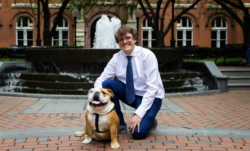Georgetown students took advantage of the two days of cancelled classes resulting from Superstorm Sandy by studying, sleeping, relaxing, or raging safely inside their heated residences. However, other members of the Georgetown community and greater D.C. area were not so fortunate.
“I was in it. I walked to Clarendon and back both days, ‘cause there was no subway,” said Richard Breault, a homeless man who braved the worst of the storm as it ravaged the East Coast earlier this week.
The lack of public transportation during and after Sandy did not just affect students and commuters. Breault, who frequently visits the Georgetown Ministry Center—a charitable organization providing outreach and services to the homeless population in the area—had to walk to and from his Extra Space Storage unit in Clarendon to pick up his daily medication.
Georgetown Ministry Center Executive Director Gunther Stern recognized the challenge faced by the community’s homeless due to the closing of D.C. public transportation during the storm. “D.C. had some shelters open,” he said, “but they weren’t nearby and needless to say the buses weren’t running, so if people were going to go there, they had to walk…a couple miles.” Stern said the closest shelter was probably on New York Ave., which was still a two- and-a-half-mile walk.
Though public transportation measures were beyond his control, Stern personally tried to ensure the well-being of the homeless community for the duration of the storm.
“I actually gave out survival blankets and sandwiches which we had until about noon. And then I left fearing the worst, but by the time I had left, pretty much everybody was gone,” he said. “I had walked around the area and encouraged the people who came by here to find shelter because my sense was that it was going to be really bad and being under a bridge wouldn’t be good enough.”
Luckily, many homeless people, such as Shannon Scannell, were able to find alternative shelter. “They opened up the Guy Mason Recreation Center about ten blocks from Safeway,” she said. “They opened up and they’re really great, nice and clean, great people. They stayed open [through the storm], but they closed down because the weather is better now. But everything was great during the hurricane.”
Breault was able to seek refuge at the Western Presbyterian Church on Virginia Ave., which was the only place he knew would be open. “No matter what, they’re always open, 365 days a year,” he said. “As long as the generator doesn’t fail and they don’t lose electricity, they’re open. It’s where I went to eat.” He also noted that Miriam’s Kitchen—a soup kitchen and support center on Virginia Ave. and G St.—was also a helpful resource, a sentiment echoed by Sannell.
“Miriam’s Kitchen is great, I go there every morning for breakfast. Most of the time I go there for dinner,” Sannell said. “They have references and they help a lot. Miriam’s Kitchen and the [Georgetown] Ministry are my two top choices.”
Fortunately, no tragedies have been reported, and some members of the homeless community even saw the storm as just another story to tell. Referring to the powerful wind gusts of Superstorm Sandy, Georgetown Ministry Center visitor Doretha Pearce joked, “I was like Mary Poppins!” She also said, “It’s a lot of excitement. It’s just like ‘Storm Chasers.’ I survive out here. I’ve seen worse.”
However, Stern was glad he took precautionary measures, since even the slightest effort can go a long way. “One person said the survival blanket I gave them was perfect, it kept the wind off of them, it was waterproof,” he said. Stern also said that he was not the only one in Georgetown who was keen to help. “There have been a couple volunteers who have wondered if there’s anything they could do,” he said. “Georgetown students were offering to do something.”
The Georgetown Ministry Center, located on Wisconsin Ave. between M St. and the Waterfront, acknowledged the importance of improving preparedness for the homeless population. Stern said, “I think for the future, we really have to plan for these weather emergencies where not only is it bad being out, but the buses aren’t running so people can’t get places.”




